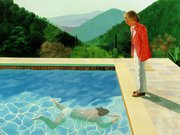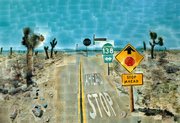David Hockney
|
|
David Hockney,CH (born July 9, 1937) is a British artist, based in California. His work is largely personal and autobiographical, with his paintings of swimming pools in Los Angeles among his best known pieces.
Hockney was born in Bradford and educated at Bradford Grammar School and the Royal College of Art in London where he met R. B. Kitaj. He became associated with pop art, but his early works also display expressionist elements, not dissimilar to certain works by Francis Bacon. Sometimes, as in We Two Boys Together Clinging (1961), named after a poem by Walt Whitman, these works make reference to his homosexuality.
Later, a visit to California, where he settled, inspired Hockney to make a series of oil paintings of swimming pools in Los Angeles. These are executed in a more realistic style and use vibrant colours. He also made prints, portraits of friends, and stage designs for Glyndebourne, La Scala and the Metropolitan Opera in New York City.
Hockney studied lithography in art school in Bradford, Yorkshire. His first print was Myself and My Heroes (1961), where he appears beside a haloed Mahatma Gandhi and Walt Whitman. His first major project in printmaking was a series a sixteen etchings where he represents Hogarth's Rake's Progress autobiographically. In the 1960s in California, he created with Ken Tyler another series of prints titled A Hollywood Collection. Many of his lithographs are portraits of his friends, most frequently of them Celia Birtwell. His first prints during the 1980s were two large lithographs of Celia published by Gemini G.E.L. (the studio started by Ken Tyler) in 1982. Hockney also made two etchings honoring Pablo Picasso, whose work he admired and was influenced by, after Picasso's death in 1973.
Hockney also worked with photography, or more precisely - photocollaging. Using varying numbers (~5-150) of small polaroid snaps or photolab-prints of a single subject Hockney arranged a patchwork to make a composite image. Because these photos are taken from different perspectives and at slightly different times, the result is work which has an affinity with cubism, affinity which was some of Hockney's major aims - discussing the way human vision works. Some of these pieces are landscapes, others portraits.
These photographic collages appeared mostly in his works between 1970 and 1986. He referred to them as "joiners". He began this style of art by taking polaroid photographs of one subject and arranging them into a grid layout. The subject would actually move while being photographed so that the piece would show the movements of the subject seen from the photographer's perspective. In later works Hockney changed his technique and moved the camera around the subject instead.
Hockney's creation of the joiners were never planned, he just sort of discovered them. He noticed in the late sixties that photographers were using cameras with wide-angle lenses to take pictures. He didn't like them because the photographs were distorted in ways that a person never sees. It was not consistent with human vision. He was working on a painting of a living room in Los Angeles in which the living room and terrance were combined into one picture at the time. He took polaroid shots of the living room and glued them together, not intending for them to be a composition on their own. Upon looking at the final composition, he realized it created a narrative as if the viewer was moving through the room. He began to work more and more with photography after this discovery and even stopped painting for a period of time to pursue this new style of photography.
Hockney was commissioned to design the cover and a series of pages for the December 1985 issue of the French edition of Vogue magazine. In consistency with his interest in cubism and admiration for Pablo Picasso, Hockney chose to paint Celia Birtwell (who appears in several of his works) with different views of her facial features as if the eye had scanned her face diagonally.
Another important commission of his was to draw with the Quantel Paintbox, a computer program that allowed the artist to sketch direct onto the monitor screen. This commission was taken by Hockney in December 1985. Using this program was similar to drawing on the Mylar for prints which he had much experience in. His works were so successful that a video was made while he was using the Quantel and broadcast by the BBC. His work with the Quantel showed him that new technology could be used for art.
In the 2001 television programme and book, Secret Knowledge, Hockney posited that the Old Masters had used the camera obscura, a series of lenses or mirrors, to project an image of their models onto the canvas, which they had then traced around, enabling them to achieve very high levels of realism.
In 1974, Hockney was the subject of Jack Hazan's film, A Bigger Splash (named after one of Hockney's swimming pool paintings from 1967). Hockney was made a Companion of Honour in 1997 and is also a Royal Academician. Many of Hockney's works are now housed in the old mill Salts Mill in Saltaire, near his home town of Bradford.
External links
- Salts Mill (http://www.saltsmill.org.uk/galleries.htm) in Saltaire, Yorkshire, England, is part owned by Hockney's brother and contains a permanent exhibition of Hockney's work.
- DavidHockney.com (http://www.davidhockney.com) tribute site.
- Peter getting out of Nick's pool (1966) (http://www.liverpoolmuseums.org.uk/walker/collections/20c/hockney.asp)
- 'Why David Hockney Should Not Be Taken Seriously' (http://www.artrenewal.org/articles/2004/Hockney/yoder1.asp) a critique of Hockney's suggestion that many Old Masters achieved realism in their paintings by using a camera obscura.
- Secret Knowledge (http://www.arcspace.com/news/hockney/): about Hockney's book and the eponymous documentary, which outline his case for asserting that the Old Masters used cameras.
- A petition against Hockney's view on the camera obscura (http://www.ipetitions.com/campaigns/debunking_david_hockney_theory/)de:David Hockney
fr:David Hockney he:דיוויד הוקני nl:David Hockney ja:デイヴィッド・ホックニー pt:David Hockney


